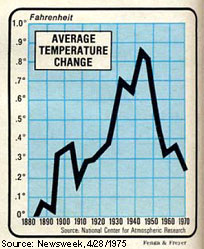 Under the headline “The Cooling World,” a 1975 Newsweek article cited National Oceanic and Atmospheric Administration research that showed a drop in North America ground temperatures of one-half of one degree between 1945 and 1968 and satellite photos that revealed a “sudden, large increase in Northern Hemisphere snow cover.” The article went on to propose that the world was entering a “little ice age.”
Under the headline “The Cooling World,” a 1975 Newsweek article cited National Oceanic and Atmospheric Administration research that showed a drop in North America ground temperatures of one-half of one degree between 1945 and 1968 and satellite photos that revealed a “sudden, large increase in Northern Hemisphere snow cover.” The article went on to propose that the world was entering a “little ice age.”
My intent in referencing this egregious article is not to debate “global cooling” – I mean “global warming” – I mean “climate change.” Rather, it is to highlight that journalists often have a very hopeless world view. Irrespective of the facts at hand, they often relish in proclaiming mankind’s imminent demise. Let’s face it, sex sells and so do doom and gloom.
Fortunately for mankind, entrepreneurs do not hope they can make an impact. They act. Improvements in mankind’s lot arise from entrepreneurs who ignore the headlines, hope less and act more to improve their lives as well as the well being of those around them.
If you haven't already subscribed yet, subscribe now for
free weekly Infochachkie articles!
Hope of Deliverance
There are two kinds of discontent in this world: the discontent that works, and the discontent that wrings its hands. The first gets what it wants. The second loses what it has. There's no cure for the first but success, and there's no cure at all for the second.
– Gordon Graham, Author and Philosopher
Hope is the confident expectation that someone or something will change one’s circumstances for the better. Hope is passive. Hope changes nothing. As such, successful entrepreneurs do not rely on hope.
Hoping less is not equivalent to defeatism, nor does it imply that entrepreneurs should be pessimists. On the contrary, entrepreneurs who perpetually see the proverbial glass as overflowing are properly motivated to survive a startup’s grueling emotional rollercoaster. As discussed in Great Expectations, such perpetual optimism is necessary to maintain the confidence of employees, investors and other stakeholders.
However, a successful entrepreneur’s optimism is not baseless. On the contrary, it is founded on the Three C’s Of Wealth Creation – confidence, courage and conviction – not on an idle hope that some exogenous factor will cause him to succeed.
Good News Is Bad News - Bad News Is Great News
In contrast to the typical entrepreneur’s sanguine view of the world, as noted in Conventional Wisdom Isn’t, many journalists see the world in a much more negative light. During the typical television news hour, good news is often relegated to the final minutes, after the viewer has been subjected to assorted murders, accidental deaths, fires, scandals, etc. Unfortunately, there is a lot of truth to the TV News adage: “If it bleeds, it leads.”
Contrary to the predominately negative headlines, the world has been and continues to “get better,” largely because of the efforts of entrepreneurs who ignore the continuous flow of bleak media messages and focus on creating something out of nothing.
 Stephen Moore’s and Julian Simon’s book, It’s Getting Better All The Time is a testament to the dramatically positive impact entrepreneurs have had on mankind’s collective quality of life during the past century. The book depicts “The Greatest Trends of the Last 100 Years” via pithy text, charts and straightforward graphs.
Stephen Moore’s and Julian Simon’s book, It’s Getting Better All The Time is a testament to the dramatically positive impact entrepreneurs have had on mankind’s collective quality of life during the past century. The book depicts “The Greatest Trends of the Last 100 Years” via pithy text, charts and straightforward graphs.
I culled a few trends which are most representative of the fact that “the good old days” were not nearly as good as our primitivism tendencies would lead us to believe. Each of these trends was born from the dedicated, hard work of one or more entrepreneurs who worked more and hoped less.
Note: Source of all the following charts and graphs: It’s Getting Better All The Time
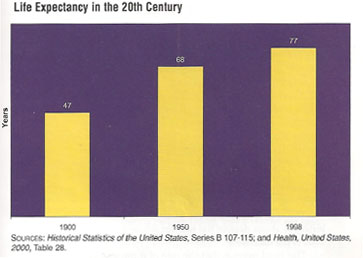 As noted at left, the average American’s lifespan increased nearly 64% during the 20th century. More significantly, life spans for both sexes and all races also increased significantly during the same period. Not just the wealthiest members of our societies are enjoying longer lives – all socioeconomic stratas have reaped the rewards of medical and life science innovations.
As noted at left, the average American’s lifespan increased nearly 64% during the 20th century. More significantly, life spans for both sexes and all races also increased significantly during the same period. Not just the wealthiest members of our societies are enjoying longer lives – all socioeconomic stratas have reaped the rewards of medical and life science innovations.
Hopeless headlines decry the increasing rates of heart disease and cancer. What the accompanying stories often do not communicate is that such debilitating ailments claim more lives each year because fewer people in past generations lived long enough to fall victim to such “old age” diseases.
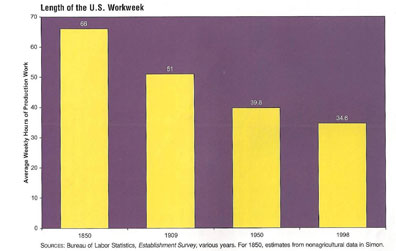 Despite the pop culture myth that “we are working more and more for less and less,” the facts tell a different story. As noted in the accompanying graph, the average work week in the U.S. has decreased nearly 50% during the past 150 years.
Despite the pop culture myth that “we are working more and more for less and less,” the facts tell a different story. As noted in the accompanying graph, the average work week in the U.S. has decreased nearly 50% during the past 150 years.
Not only have entrepreneurial breakthroughs led to longer life spans, entrepreneurial innovations have transformed the quality of modern life such that today’s poor routinely enjoy luxuries unheard of 100 years ago, even among the aristocracy of the 19th century.
Given that Americans are working less and living longer, their leisure time has risen substantially. When this discretionary time is converted into years, the advancement over the past 120 years is dramatic, rising from a measly 11 years (essentially one’s childhood) to a threefold increase of 35 years. Modern man’s leisure time is nearly equivalent to the average 19th century worker’s entire lifespan.
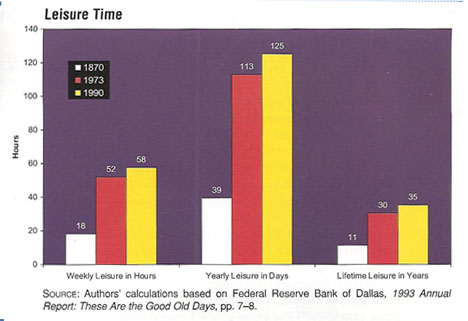
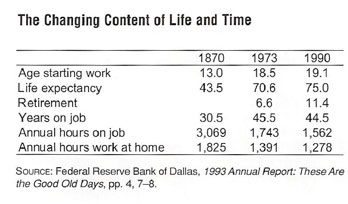
As noted in the chart at left, Americans have consistently started working later in life and have enjoyed a growing number of years of retired living. However, a hopeless headline that could be drawn from this data is “Americans Now Spending More Years On The Job Than Ever Before.” Although such a headline would be factually correct, it would omit the positive market factors underlying the data.
A common refrain when people recall the past is a longing for yesteryear’s “low prices.” For instance, one might ask, “Whatever happened to McDonald’s thirty-cent hamburger?” The answer is that the price has not increased. Rather, it has diminished steadily over the past seventy years.
In 1940, that thirty-cent hamburger represented approximately one half-hour of the average worker’s wage. Modern McDonald’s customers only have to work approximately nine minutes to earn the income required to purchase a Big Mac, which is larger and more nutritious than its 1940s predecessor. The current price of a Hershey’s chocolate bar is equivalent to a few minutes of the average American’s labor, one-tenth of the equivalent price of the same candy bar 100 years ago.
In reality, most historical prices were considerably higher than their modern equivalents, when the amount of work required to purchase the goods is taken into account. As the chart below makes clear, necessities such as baking soda, pencils, nails and socks all cost modern buyers a fraction of the prices paid by consumers 100-years ago. The next time you read a headline condemning price increases, keep in mind that the continual march toward greater efficiencies and productivity serve to reduce many prices, in real terms.
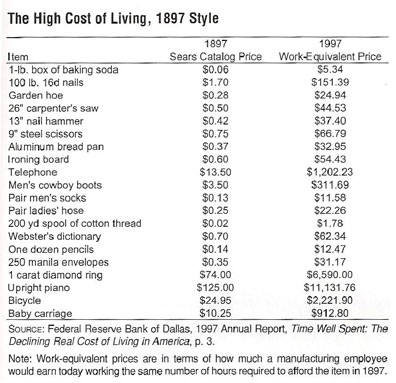
Not only are Americans living longer, with greater leisure time and lower prices, they can expect more of the same in the years ahead. The rate of innovation accelerated with each passing year during the past century, as evidenced by the continual rise in the number of patents issued during the 20th century. As noted in the graph below, from 1978 to 1998, the total number of patents issued more than doubled.
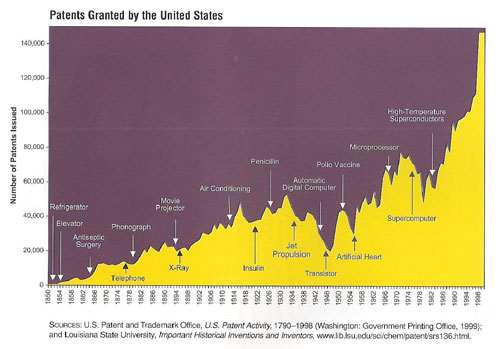 Newsweek’s Wrong Again
Newsweek’s Wrong Again
In 1980, Newsweek magazine reported the following, based on a U.S. Government Report entitled Global 2000.
“The year: 2000. The Place: Earth, a desolate planet slowly dying of its own accumulating follies. Half the forests are gone; sand dunes spread where fertile lands once lay. Nearly 2 million species of plants, birds, insects and animals have vanished. Yet man is propagating so fast that his cities have grown as large as his nations a century before.”
Do not hold your breath waiting for a retraction. Instead, hope less and focus on turning your entrepreneurial dreams into commercial realities that will benefit all of mankind, even the naysayers at Newsweek and their hopeless brethren.
______________________
John Greathouse has held a number of senior executive positions with successful startups during the past fifteen years, spearheading transactions which generated more than $350 million of shareholder value, including an IPO and a multi-hundred-million-dollar acquisition.
John is a CPA and holds an M.B.A. from the Wharton School. He is a member of the University of California at Santa Barbara’s Faculty where he teaches several entrepreneurial courses. He is also the author of an award-winning entrepreneurial blog infoChachkie.com. You can learn more about his experiences at johngreathouse.com
______________________
<
Copyright © 2007-9 by J. Meredith Publishing. All rights reserved.




Pingback: A Startup’s Net Profit Score Is More Important Than Its Net Promoter Score | infoChachkie